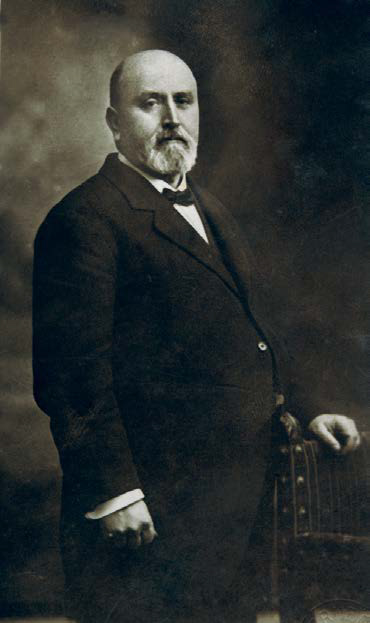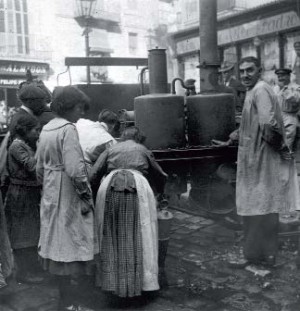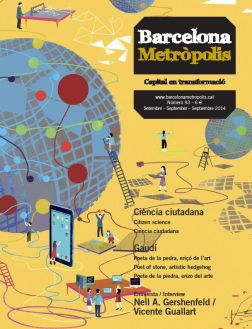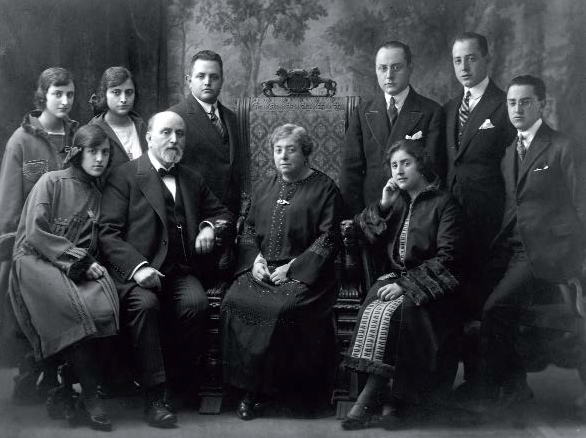Doctor Manuel Ribas i Perdigó, born in 1859 in a chocolate shop in Carrer de Ferran, graduated in 1880. Four years later he took up a teaching position at the School of Medicine, where he was to become the most important colleague of the future mayor of Barcelona, Doctor Robert. He chaired the Royal Academy of Medicine from 1924 until his death, in 1927.
There was a time when the inhabitants of Barcelona commended their soul to God and their body to a doctor with a patriarchal, ceremonious and serious air, a top hat, morning coat and a black leather briefcase, like the ones carried by the aides of nineteenth-century duellists. They used to sport a well-trimmed, thick and rounded-off white beard, although the more extravagant ones opted for a goatee. A goatee is hardly advisable in a doctor, as they run the risk of being laughed at by their patients.
Things were different then. The locals of the time had more faith than they do now. Faith in the Sacred Heart, in anarchy or the Castellví mechanical brake. In that credulous, turbulent and occasionally choleric Barcelona, we do not know what led Manuel Ribas i Perdigó, the second son of a chocolate-maker and grandson of farmers from Hortes de Sant Bertran, to embrace the medical career. Perhaps to follow in the footsteps of his brother John, two years his senior. In any event, young John and Manuel followed the example of the brother physicians Saint Cosmas and Saint Damian (although thankfully they – literally – managed to keep their heads).
Manuel Ribas i Perdigó was born in 1859 in a mezzanine of the Ribas chocolate shop at Carrer de Ferran number 16 in Barcelona, an establishment greatly appreciated for its excellent cocoa, which was shipped to Vilanova i la Geltrú from Guinea. That chocolate shop must have been held in high esteem throughout the city, as it fell foul of the satirical wrath of Pitarra, an honour reserved for the chosen few.

© Rosa Ribas Boixeda Archive
A portrait from 1925, when she was already president of the Royal Academy of Medicine.
We know little about the early years, although we do know that in 1870 the family took refuge in a summer home in Bonanova, at the top of Carrer Muntaner, during the terrible yellow fever epidemic, also known as the black vomit (they could hardly have come up with a more horrifying name). Perhaps it was then, on beholding such deathly despair, that the two boys decided to devote their lives to medicine. It is unlikely that they were driven to do so by the sight of a callus.
In 1880, Manuel Ribas i Perdigó graduated in medicine and obtained the extraordinary award granted following the wedding of Alfonso xii and Maria Cristina. He took his doctorate in Madrid and toured medical institutions in Germany for half a year. There, he acquired a Germanic lifestyle, regular and pondered, including, among other habits, that of checking the exact time on the clock of the Royal Academy of Sciences every day: a custom that has endured among some of his descendants, as has his contempt for music.
After his German adventure, he returned to Barcelona in 1884 and obtained a position as clinical professor in the School of Medicine. His speciality was the treatment of internal diseases, particularly of the digestive, cardiovascular and respiratory apparatuses – everything you might find at an offal stall in the market.
The professor of Internal Medicine was Dr Bartomeu Robert, the future mayor of Barcelona. Dr Ribas i Perdigó became his greatest colleague, and friend as well, and stood in for Dr Robert when the latter had to attend to his political duties. Humble, cordial and very precise in his explanations, Ribas i Perdigó the teacher was greatly appreciated by his students, such as the doctors Pedro Pons, Nobiola, Pi i Sunyer, Bartrina and others who, after qualifying, often consulted him.
When he sat the public examinations in Madrid to become professor at the University of Zaragoza, Ribas i Perdigó lost out to another student who had more backing, and returned disappointed to Barcelona. “Never again will I set foot in Madrid,” he concluded. The years went by, and he remained true to his word.
He wrote Patogenia y tratamiento de la constipación habitual (on constipation), Diagnóstico y tratamiento de la gastroectasia (on stomach dilation) and Tratamiento de la neurastenia (where he recommended the restriction of intercourse in infirm patients as it weakened them, although, it must be said, it is also quite reviving).
In 1898 he became a member of the Royal Academy of Medicine of Barcelona, which he chaired as of 1924, giving the speech Tratamiento curativo de la tuberculosis pulmonar. His great friend, Dr Robert, vouched for him. It should also be mentioned that in 1909 he read the opening speech of the Royal Academy, Tratamiento general de la arterioesclerosis, a mere 72 pages – one of the longest on record.

© Frederic Ballell / AFB
A water purification machine in the Plaça del Pedró, in 1914, when Barcelona suffered a serious Typhus epidemic which killed almost two thousand people.
In 1888, Ribas i Perdigó married the nineteen-year-old Carme Casas i Güell, with whom he would have nine children: Cristina, Margarida (deceased at the age of three), Joan (ophthalmologist), Bonaventura, Josep (my grandfather), Antoni (ear, nose and throat specialist), Maria, Margarida (much stronger than her earlier and short-lived sibling) and Mercè. I would like to convey my special thanks to Dr Manuel Ribas i Fernández – the grandson of doctor Joan Ribas i Perdigó – for his Memòria del doctor Manuel Ribas i Perdigó, which was of great help to me in penning this portrait.
In the first few years he lived at Rambla de Sant Josep number 37, opposite the church of Betlem, in the house called El Regulador, and opened his practice at Carrer Santa Anna number 24. For some time he postponed moving to Rambla de Catalunya number 11, fearing that patients would not risk crossing Plaça de Catalunya, which was windy, poorly lit and populated with outlandish and blurry-eyed individuals. Not unlike today.
Finally, around 1895, he decided to move home and practice to the somewhat secluded house on Rambla de Catalunya. The office has been conserved to this day, thanks to the widow of Dr Manuel Ribas i Mundó, who was professor of internal medicine at the Autonomous University of Barcelona and grandson of Manuel Ribas i Perdigó.
He participated in the Medical Sciences Congress held in Barcelona in 1888 as part of the Universal Expo, with Papel que representan las enfermedades extracardíacas en el descubrimiento de la asistolia (no need to feel depressed, I didn’t understand anything either) and the International Medical Congress of Moscow in 1894 with Formas clínicas de la cirrosis hepática.
After the death of Dr Robert in 1902, he left the university to focus on private medicine. Not only did he attend to patients in Barcelona and the surrounding area, he also saw patients in Paris, a city he travelled to frequently. He must have been quite satisfied, because Paris vaut bien a patient.
In 1914, at the request of Barcelona City Council he participated in a medical committee tasked with fighting the typhus epidemic that was ravaging the city. One of his indications handed down from generation to generation is that the black spots found on tomatoes can trigger typhoid, and consequently none of his descendants partake of this fruit. Right now, frankly speaking, the last thing we need is typhus.
In 1924, Dr Ribas i Perdigó was named president of the Royal Academy of Medicine of Barcelona – which was changed to “of Catalonia” in 1991 by a plenary agreement – and his presidency coincided with the commemoration of the centenary of the death of Dr Salvà i Campillo, not without a certain degree of tension with the military government of General Primo de Rivera. He was president for three years, as in 1927 he fell ill with stomach cancer and died six months later.
When doctors die on us, we become a little bit lonelier.





Interesant article. Graciés. El meu avi es vall Perdigó i familia teva.
Un salut